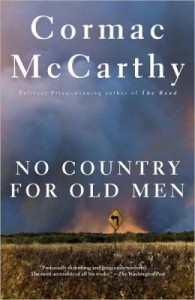 Action-Thriller With Literary Chops
Action-Thriller With Literary Chops
McCarthy, Cormac. (2005). No Country for Old Men. New York: Vintage.
An aging sheriff in 1980’s Texas despairs over the violent crime drugs trafficking has brought to his county, making it into a landscape he hardly recognizes. Thus the title of the book.
The story begins when a local welder, Moss, is hunting. He stumbles across bullet-riddled vehicles, dead bodies, and a canvas bag containing $2.5 million. He takes the money (notwithstanding the weight, overlooked in the story. That much money in hundreds would weigh over 200 pounds). Later he returns to the scene, and is spotted by drug mobsters who want the money. Moss gets shot up, but escapes, and the chase is on.
Investigating the mass murder, Sheriff Bell realizes Moss is involved somehow, and searches for him. Meanwhile a rogue psychopath, Chigurh, relentlessly hunts Moss to get the money. At the same time, a psychopath hit man is hired by the drug cartel to kill Chigurh. There’s some good cat-and-mouse, multiple shootouts, lots of blood, innocent victims, and shattered glass.
How does it turn out? The ending is inconclusive. The story just stops when McCarthy hit his page count. Consequently, the novel has no particular meaning or message, beyond the book’s title. Sheriff Bell waxes philosophical at the end, in a failed attempt to inject some meaning through deadly backstory.
With the exception of that final 40 pages, the book is well-written, extremely well-edited, with some innovations in narration and dialog that any writer can learn from. The book is an easy read, although it helps if you’ve seen the movie because the storyline in the book is so compressed, it is often not clear how characters seem to know what they know, and why they appear unexpectedly where they do. The movie wisely omits that last 40 pages of marshmallow-speak, but otherwise is faithful to the book. You can’t read Sheriff Bell’s lines without hearing the voice of Tommy Lee Jones.
There’s no punctuation beyond periods, question marks, and capitalized names and first words of sentences. There are few commas, which keeps the action moving breathlessly, as do the short sentences. The lack of apostrophes can be annoying in contractions and possessives, but having no quotation marks is the most noticeable formatting innovation. Why no quote marks?
Bell nodded. I aint a stranger to them thoughts, Carla Jean. I am very familiar with them thoughts.
In part, the lack of quotation marks might be a stylistic flair that comports with the characters’ simple lives and language. On the other hand, it may be related to McCarthy’s innovative narrator. Unlike many third-person narrators today, this one is not “close,” that is, he never gets intimate with the characters. Rather, he reports their behavior from the outside, without judgment or comment.
He went into the bathroom. He ran his forefinger around the sink. A washcloth and handtowel had been used but not the soap. He ran his finger down the side of the tub and then wipe it along the seam of his trousers. He sat on the edge of the tub…
This is pure behavioral narration that deprives the character of interiority. We never know what a character is thinking or feeling, or what he wants, except as we can infer it from his behavior. But if that kind of behavioral reporting were continued indefinitely, the reader would become bored, because a person’s external behavior is not rich enough to satisfy our need to understand characters.
So McCarthy fudges the narrator’s behavioral constraint in several subtle ways, one of which is to omit the quotation marks. In the dialog sample above, we are almost inside the head of Sheriff Bell, who is saying what he knows and feels. Except he’s not really saying it because there are no quotation marks. The narrator could throw up his hands and say, “Hey, I didn’t make Bell say that. Look, there are no quote marks! I’m strictly on the outside, here.” It’s a cheap gimmick, but it does soften the harshness of pure behavioral reporting.
There are other techniques used to accomplish the same end. Action chapters, all in 3P-omniscient behaviorism, alternate with short, italicized chapters in Sheriff Bell’s first-person voice. In those chapters, Bell spills his guts to the reader about what he thinks, believes, feels, values, hopes for, worries about, and so on. They are confessional, and their intimacy stands in sharp contrast to the 3P narrator’s objectivity.
There are many other writing innovations in the book, although they would probably only be noticed by other writers, yet they do contribute overall to the book’s fatalistic tone and dark mood, making it a literary success as well as a competent thriller.
